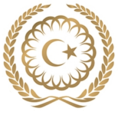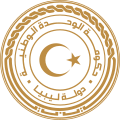
A crescent shape is a symbol or emblem used to represent the lunar phase in the first quarter, or by extension a symbol representing the Moon itself.

The flag of Iraq includes the three equal horizontal red, white, and black stripes of the Arab Liberation flag, with takbīr ʾAllāhu ʾakbaru, meaning "Allah (God) is the greatest" in Kufic script written in the center.

The national flag of Libya was originally introduced in 1951, following the creation of the Kingdom of Libya. It was designed by Omar Faiek Shennib and approved by King Idris Al Senussi who comprised the UN delegation representing the three regions of Cyrenaica, Fezzan, and Tripolitania at UN unification discussions.
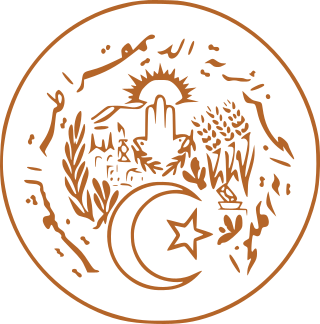
The national emblem of Algeria is the seal used by the government, as other states use coats of arms.

The national flag of Egypt is a tricolour consisting of the three equal horizontal red, white, and black bands of the Egyptian revolutionary flag dating back to the 1952 Egyptian Revolution. The flag bears Egypt's national emblem, the Egyptian eagle of Saladin centered in the white band.
As a result of the Syrian Civil War since 2011, there are at least two flags used to represent Syria, used by different factions in the war. The incumbent government of the Syrian Arab Republic led by the Ba'ath Party uses the red-white-black tricolour originally used by the United Arab Republic, while Syrian opposition factions such as the Syrian National Coalition use the green-white-black tricolour known as the ''Independence flag'', first used by Mandatory Syria.
This armorial of sovereign states shows the coat of arms, national emblem, or seal for every sovereign state. Although some countries do not have an official national emblem, unofficial emblems which are de facto used as national emblems are also shown below.
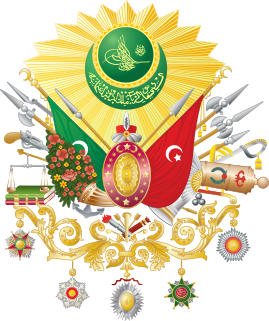
Every sultan of the Ottoman Empire had his own monogram, called the tughra, which served as a royal symbol. A coat of arms in the European heraldic sense was created in the late 19th century. Hampton Court requested from the Ottoman Empire a coat of arms to be included in their collection. As the coat of arms had not been previously used in the Ottoman Empire, it was designed after this request, and the final design was adopted by Sultan Abdul Hamid II on 17 April 1882.

The star and crescent is an iconographic symbol used in various historical contexts, including as a prominent symbol of the Ottoman Empire, with numerous modern countries still using it as a national symbol. It was developed in the Greek colony of Byzantium ca. 300 BCE, though it became more widely used as the royal emblem of Pontic king Mithradates VI Eupator after he incorporated Byzantium into his kingdom for a short period. During the 5th century, it was present in coins minted by the Persian Sassanian Empire; the symbol was represented in the coins minted across the empire throughout the Middle East for more than 400 years from the 3rd century until the fall of the Sassanians after the Muslim conquest of Persia in the 7th century. The conquering Muslim rulers kept the symbol in their coinage during the early years of the caliphate, as the coins were exact replicas of the Sassanian coins.

The coat of arms of Egypt is known as the Republican Eagle or Egyptian Golden Eagle, is a heraldic golden eagle, facing the viewer's left (dexter). The eagle's breast is charged with an escutcheon bearing the red-white-black bands of the flag of Egypt rotated vertically, whilst the eagle's talons hold a scroll bearing the official name of the state written in Kufic script. The earliest version of the Eagle of Saladin was that used as the flag of Saladin, the first Sultan of Egypt, whilst the modern version of the eagle was adopted during the Egyptian Revolution of 1952. Subsequently, the modern design of the Eagle of Saladin was adopted as the coat of arms of numerous other states in the Arab World, namely the United Arab Republic, North Yemen, Iraq, South Yemen, the Libyan Arab Republic, and Palestine. The current eagle was modified in 1984 to its present form.
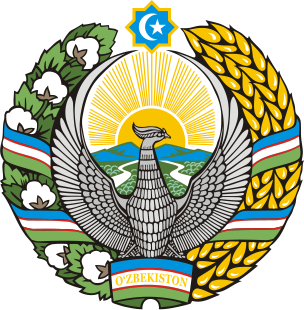
The state emblem of Uzbekistan was formally adopted on July 2, 1992 by the newly establish Republic of Uzbekistan. It bears many similarities to the emblem of the previous Uzbek SSR, which Republic of Uzbekistan succeeded. Like other post-Soviet republics whose symbols do not predate the October Revolution, the current emblem retains some components of the Soviet one. Prior to 1992, Uzbekistan had an emblem similar to all other Soviet Republics, with standard communist emblems and insignia.

Turkey has no official national emblem, but the crescent and star design from the national flag is in use as the de facto national emblem on Turkish passports, Turkish identity cards and at the diplomatic missions of Turkey.

The coat of arms or state emblem of Iraq is a golden black eagle looking towards the viewer's left dexter. The eagle is the Eagle of Saladin associated with 20th-century pan-Arabism, bearing a shield of the Iraqi flag, and holding a scroll below with the Arabic words جمهورية العراق.
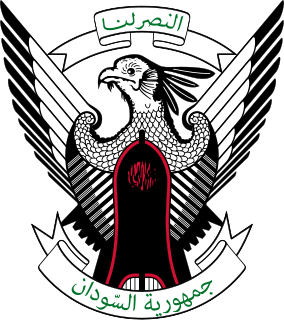
The current national emblem of Sudan was adopted in 1985.

The current coat of arms of Syria or coat of arms of the Syrian Arab Republic was adopted in 1980, following the 1977 dissolution of the Federation of Arab Republics, whose coat of arms had until then been used by its constituent states. This emblem consist of the Hawk of Quraish supporting a shield bearing the national flag of Syria, and a scroll of the words "Syrian Arab Republic" in Arabic. Since the start of the ongoing Syrian Civil War in March 2011, alternative coats of arms have been created by the Syrian opposition and the Federation of Northern Syria.
An Islamic flag is a flag either representing an Islamic denomination or religious order, state, civil society, military force or other entity associated with Islam. Islamic flags have a distinct history due to the Islamic prescription on aniconism, making particular colours, inscriptions or symbols such as crescent-and-star popular choices. Since the time of the Islamic prophet Muhammad, flags with certain colours were associated with Islam according to the traditions. Since then, historical Caliphates, modern nation states, certain denominations as well as religious movements have adopted flags to symbolize their Islamic identity.

The emblem of the United Arab Emirates was officially adopted on 9 December 1973 ; it was later modified in 2008. It is similar to the coats of arms and emblems of other Arab states.

The coat of arms of Palestine may refer to the emblem used by the State of Palestine and Palestinian National Authority (PNA) or to the emblem used by the Palestine Liberation Organization (PLO).

The Hawk of Quraish is a symbol which is found on a number of emblems, coats of arms and flags of several states of the Arab League. The Arabs of the Arabian Peninsula, today especially those from the Arab side of the Persian Gulf coast, are traditionally falconry experts; falcons are seen as status symbols and are a common domesticated animal among ethnic Arabs. Also the traditions and recorded history about the Quraysh and Muhammad claim a falcon had been used as clan symbol. Therefore, several variants of the Quraishi hawk were and are seen in the flags, coat of arms, seals and emblems of several Arab states until today. In that meaning, the Hawk of Quraish is a rival to the Eagle of Saladin.

The Eagle of Saladin, known in Egypt as the Egyptian Eagle, and the Republican Eagle, is a heraldic eagle that serves as the national symbol and coat of arms of Egypt, Iraq, Palestine, and of the Southern Transitional Council of South Yemen. Since the Egyptian Revolution of 1952, the eagle has been an iconic symbol of Egypt, and of Arab nationalism, particularly in Arab states that underwent anti-imperialist political change from the 1950s onwards. It was formerly the national symbol of the now defunct United Arab Republic, North Yemen, South Yemen, and the Libyan Arab Republic.













